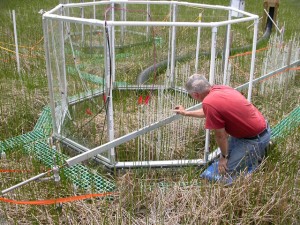Pat Megonigal is a biogeochemist here at the Smithsonian Environmental Research Center (SERC). The following is an interview with him about his recent research.

Smithsonian biogeochemist Pat Megonigal
Climate change scenarios are driven largely by greater concentrations of carbon dioxide in the atmosphere. One common narrative includes faster-rising seas and the potential drowning of coastal regions. You recently published a paper in the Proceedings of the National Academy of Sciences that gives hope to some coastal wetlands. Tell us what you found.
PM: We conducted a study for two years on the Kirkpatrick Marsh, here on the Chesapeake Bay. We discovered that higher levels of atmospheric CO2 actually stimulated the surface elevation of saltwater marshes. The additional CO2 caused them to basically pop up, or rise in elevation, because the plants developed more roots. It’s kind of a silver-lining story.
How did you simulate climate change?
PM: We put out clear open-top chambers that are about two yards in diameter. They allow us to manipulate the atmosphere around a chunk of marsh. Then, in some of the chambers, we pumped in extra CO2; we raised it to a level that will be roughly what the whole world will be exposed to at the end of the century. And then we measured the changes in the soil’s elevation throughout the growing season.
When you think of measuring elevation, mountains come to mind, not soil. How did you measure the soil’s height?
PM: Well, we needed a stable point of elevation reference, so first we drove a steel rod about 20 feet into the ground. Then came the hard part. We had to design a tool that would give us not only precise, but multiple measurements of the soil elevation – both in and outside of our chambers. We came up with an instrument we dubbed the “monster arm.”

Technician Jim Duls measures the soil elevation with the 'monster arm.'
The monster arm?
PM: The technical name is “surface elevation table.” Basically it’s a long metal bar with 90 fiberglass pins running perpendicular through it. It looks like a big comb, but instead of the teeth being fixed in place, they can move up and down. So by gently placing the monster arm across the chambers we could measure where the top of each pin was in relation to the main crossbar. So if a pin rose 100 millimeters above the bar in April and in August it rose 102 millimeters, the soil elevation increased by two millimeters.
Your study showed that the marsh receiving the extra CO2 rose by an additional 3mm a year. Is that enough to keep pace with the rising sea level?
PM: It should help for a while, but we don’t know how much sea level rise a marsh can handle before it will disappear. We do know that rising sea level is one reason that some marshes in mid-Atlantic and around the world are disappearing right now. Our research indicates that some of these wetlands literally have an organic ability to fight back by building new soil. This is especially true for wetlands with brackish water, like Kirkpatrick Marsh. Saltier coastal wetlands won’t be able to accumulate as much soil because their plants are different and don’t respond to CO2 in the same way. But we’re now conducting a new experiment to look at sea-level rise and its effect on soil elevation. We think the pop-up effect we’ve observed will be even more pronounced when the water level rises. We’ll see!

